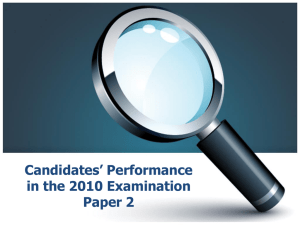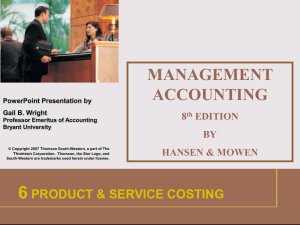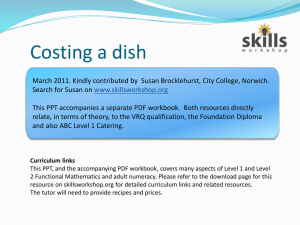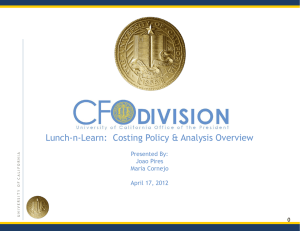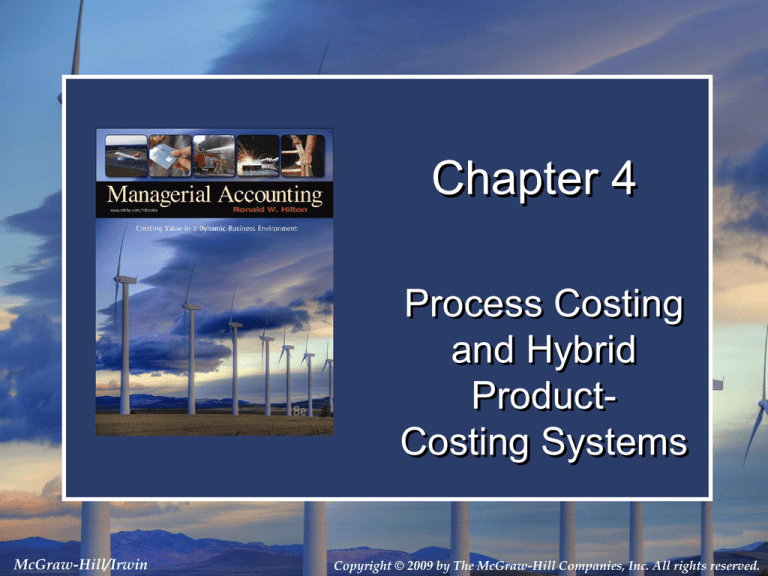
Chapter 4
Process Costing
and Hybrid
ProductCosting Systems
McGraw-Hill/Irwin
Copyright © 2009 by The McGraw-Hill Companies, Inc. All rights reserved.
Learning
Objective
1
McGraw-Hill/Irwin
Copyright © 2009 by The McGraw-Hill Companies, Inc. All rights reserved.
Comparison of Job-Order Costing
and Process Costing
Process
Process
Costing
Costing
Job-order
Costing
Used for production of small,
identical, low cost items.
Mass produced in automated
continuous production process.
Costs cannot be directly traced to
each unit of product.
4-3
Comparison of Job-Order Costing
and Process Costing
Process
Process
Costing
Costing
Job-order
Costing
Typical process cost applications:
Petrochemical refinery
Paint manufacturer
Paper mill
4-4
Comparison of Job-Order Costing
and Process Costing
Job-order costing
Process costing
– Costs accumulated by
the job.
– Costs accumulated by
department or process.
– Work in process has a
job-cost sheet for each
job.
– Work in process has a
production report for
each batch of products.
– Many unique, high cost
jobs.
– A few identical, low cost
products.
– Jobs built to customer
order.
– Units continuously
produced for inventory
in automated process.
4-5
Differences Between Job-Order
and Process Costing
The work-in-process
account consists of
individual jobs in a
job-order cost system.
Direct Material
Direct Labor
Manufacturing
Overhead
Jobs
Finished
Goods
Cost of
Goods
Sold
4-6
Differences Between Job-Order
and Process Costing
Direct Material
Direct Labor
& Overhead
(Conversion)
The work-in-process
account consists of
individual products in a
process cost system.
Products
When direct labor is a relatively small amount
compared to material and overhead, it is often
combined with overhead.
Finished
Goods
Cost of
Goods
Sold
4-7
Learning
Objective
2
McGraw-Hill/Irwin
Copyright © 2009 by The McGraw-Hill Companies, Inc. All rights reserved.
Process Cost Flows
Work-in-Process
Inventory
Direct material
Direct labor
Applied manufacturing
overhead
One Production Department
Finished Goods
Inventory
Cost of goods completed
and transferred to
finished goods
Cost of Goods Sold
Cost of goods sold
during current
period
4-9
Process Cost Flows
Two Sequential Production Departments
Work-in-Process Inventory
Work-in-Process Inventory
Production Department A
Production Department B
Cost of goods completed
Direct material
Direct labor
in department A and
Cost of goods completed
Applied manufacturing
transferred to
and transferred to
overhead
department B
finished goods
Direct material
Direct labor
Applied manufacturing
overhead
Finished Goods Inventory
Cost of Goods Sold
Cost of goods sold
during current period
4-10
Learning
Objective
3
McGraw-Hill/Irwin
Copyright © 2009 by The McGraw-Hill Companies, Inc. All rights reserved.
Equivalent Units: A Key Concept
• Costs are accumulated for a period of time for
products in work-in-process inventory.
• Products in work-in-process inventory at the
beginning and end of the period are only
partially complete.
• Equivalent units is a concept expressing these
partially completed products as a smaller
number of fully completed products.
4-12
Equivalent Units Example
Two one-half completed products are
equivalent to one completed product.
+
=
l
So, 10,000 units 70 percent complete
are equivalent to 7,000 complete units.
4-13
Equivalent Units Question 1
For the current period, Jones started
15,000 units and completed 10,000 units,
leaving 5,000 units in process 30 percent
complete. How many equivalent units of
production did Jones have for the period?
a. 10,000
b. 11,500
c. 13,500
d. 15,000
4-14
Equivalent Units Question 1
For the current period, Jones started
15,000 units and completed 10,000 units,
leaving 5,000 units in process 30 percent
complete. How many equivalent units of
production did Jones have for the period?
a. 10,000
10,000 units + (5,000 units × .30)
b. 11,500
= 11,500 equivalent units
c. 13,500
d. 15,000
4-15
Equivalent Units Question 2
If Jones incurred $27,600 in
production costs for the 11,500
equivalent units. What was Jones’s
cost per equivalent unit for the period?
a. $1.84
b. $2.40
c. $2.76
d. $2.90
4-16
Equivalent Units Question 2
If Jones incurred $27,600 in
production costs for the 11,500
equivalent units. What was Jones’s
cost per equivalent unit for the period?
a. $1.84
b. $2.40
$27,600 ÷ 11,500 equivalent units
c. $2.76
= $2.40 per equivalent unit
d. $2.90
4-17
Calculating and Using Equivalent
Units of Production
To calculate the direct materials and conversion
costs per equivalent unit for the period:
Materials
cost per
equivalent
unit
Conversion
cost per
equivalent
unit
=
=
Materials cost for the period
Materials equivalent units for
the period
Conversion cost for the period
Conversion equivalent units for
the period
4-18
Departmental Production Report
Analysis of
Calculation
physical flow
of units.
of equivalent
units.
Production
Report
Computation
Analysis of
of unit costs.
total costs.
4-19
Equivalent Units of Production –
Weighted-Average Method
The weighted-average method . . .
– Makes no distinction between work done in the
prior period and work done in the current period.
– Blends together units and costs from the prior
period and the current period.
The FIFO method is a more
complex method and is
rarely used in practice.
4-20
Production Report Example
• MVP Sports Equipment Company makes baseball gloves
in two departments, Cutting and Stitching.
• MVP uses the weighted-average cost procedure.
• Material is added at the beginning of the Cutting
Department, and conversion is incurred uniformly
throughout the process.
• Using the following information for the month of March,
let’s prepare a production report for the Cutting
Department.
4-21
Production Report Example
Work in process, March 1: 20,000 units
Materials:
100% complete.
Conversion:
10% complete.
Cost
$ 50,000
7,200
Units started into production in March:
Units completed and transferred out in March:
30,000 units
40,000 units
Work in process, March 31:
Materials
100% complete.
Conversion
50% complete.
10,000 units
Costs incurred during March
Materials cost
Conversion costs:
Direct labor
Applied manufacturing overhead
Total conversion costs
Total costs to account for
90,000
$ 86,000
107,500
193,500
$ 340,700
4-22
Production Report Example
Analysis of Physical Flow of Units
Physical
Units
Work in process, March 1
Units started during March
Total units to account for
20,000
30,000
50,000
Units completed and transferred out during March
Work in process, March 31
Total units accounted for
40,000
10,000
50,000
4-23
Production Report Example
Calculation of Equivalent Units
Physical
Units
Conversion
Percentage
Complete
Work in process, March 1
Units started during March
Total units to account for
20,000
30,000
50,000
10%
Units completed and transferred
Work in process, March 31
Total units accounted for
Total equivalent units
40,000
10,000
50,000
100%
50%
Equivalent Units
Direct
Material Conversion
50% of 10,000 units
40,000
10,000
40,000
5,000
50,000
45,000
Beginning inventory % is not used in weighted-average method.
4-24
Production Report Example
Calculation of Equivalent Units
Physical
Units
Conversion
Percentage
Complete
Work in process, March 1
Units started during March
Total units to account for
20,000
30,000
50,000
10%
Units completed and transferred
Work in process, March 31
Total units accounted for
Total equivalent units
40,000
10,000
50,000
100%
50%
Equivalent Units
Direct
Material Conversion
100% of 10,000 units, all
material added at beginning
40,000
10,000
40,000
5,000
50,000
45,000
4-25
Learning
Objective
4
McGraw-Hill/Irwin
Copyright © 2009 by The McGraw-Hill Companies, Inc. All rights reserved.
Production Report Example
Computation of unit costs
Direct
Material
Work in Process, March 1
Costs incurred during March
Total costs to account for
$ 50,000
90,000
$ 140,000
Equivalent units
Cost per equivalent unit
50,000
$
2.80
Conversion
$
7,200
193,500
$ 200,700
$
$140,000 ÷ 50,000 equivalent units
45,000
4.46
Total
$ 57,200
283,500
$ 340,700
$
7.26
$2.80 + $4.46
$200,700 ÷ 45,000 equivalent units
4-27
Learning
Objective
5
McGraw-Hill/Irwin
Copyright © 2009 by The McGraw-Hill Companies, Inc. All rights reserved.
Production Report Example
Analysis of total costs
Cost of goods completed and transferred during March
40,000 units x $7.26 per equivalent unit
Costs remaining in work-in-process on March 31
Direct Material:
10,000 equivalent units x $2.80 per equivalent unit
Convserion:
5,000 equivalent units x $4.46 per equivalent unit
Total cost of March 31 work-in-process
Total costs accounted for
$ 290,400
$ 28,000
22,300
50,300
$ 340,700
4-29
Production Report Example
Analysis of total costs
Cost of goods completed and transferred during March
40,000 units x $7.26 per equivalent unit
Costs remaining in work-in-process on March 31
Direct Material:
10,000 equivalent units x $2.80 per equivalent unit
Convserion:
5,000 equivalent units x $4.46 per equivalent unit
Total cost of March 31 work-in-process
Total costs accounted for
$ 290,400
$ 28,000
22,300
50,300
$ 340,700
4-30
Production Report Example
Analysis of total costs
Cost of goods completed and transferred during March
40,000 units x $7.26 per equivalent unit
Costs remaining in work-in-process on March 31
Direct Material:
10,000 equivalent units x $2.80 per equivalent unit
Convserion:
5,000 equivalent units x $4.46 per equivalent unit
Total cost of March 31 work-in-process
Total costs accounted for
$ 290,400
$ 28,000
22,300
All costs
accounted for
50,300
$ 340,700
4-31
Learning
Objective
6
McGraw-Hill/Irwin
Copyright © 2009 by The McGraw-Hill Companies, Inc. All rights reserved.
MVP SPORTS EQUIPMENT COMPANY
Production Report: Cutting Department
Percentage of
Completion
Equivalent Units
Physical with Respect to
Direct
Units
Conversion
Material
Conversion
Work in process, March 1
Units started during March
Total units to account for
20,000
30,000
50,000
10%
Units completed and transferred
Work in process, March 31
Total units accounted for
Total equivalent units
40,000
10,000
50,000
100%
50%
Direct
Material
Work in Process, March 1
Costs incurred during March
Total costs to account for
$ 50,000
90,000
$ 140,000
Equivalent units
Cost per equivalent unit
$
50,000
2.80
40,000
10,000
40,000
5,000
50,000
45,000
Conversion
$
7,200
193,500
$ 200,700
$
45,000
4.46
Cost of goods completed and transferred during March
40,000 units x $7.26 per equivalent unit
Costs remaining in work-in-process on March 31
Direct Material:
10,000 equivalent units x $2.80 per equivalent unit
Conversion:
5,000 equivalent units x $4.46 per equivalent unit
Total cost of March 31 work-in-process
Total costs accounted for
Total
$ 57,200
283,500
$ 340,700
$
7.26
$ 290,400
$
28,000
22,300
50,300
$ 340,700
4-33
Actual Costing
Actual costs of
manufacturing overhead
are entered in Work-inProcess Inventory
vs.
Normal Costing
Manufacturing
overhead is
applied
to Work-inProcess Inventory
using a
predetermined
overhead rate
4-34
Departmental Production Report
Analysis of
physical flow
of units.
Calculation
of equivalent
units.
Computation
of unit costs.
Analysis of
total costs.
4-35
Learning
Objective
7
McGraw-Hill/Irwin
Copyright © 2009 by The McGraw-Hill Companies, Inc. All rights reserved.
Operation Costing
Operation costing employs some aspects
of both job-order and process costing.
Job-order
Costing
Operation Costing
(Products produced in batches)
Process
Costing
4-37
Operation Costing
Operation costing employs some aspects
of both job-order and process costing.
Job-order
Costing
Operation Costing
(Products produced in batches)
Material Costs charged
to batches as in
job-order costing.
Process
Costing
Conversion costs
assigned to batches
as in process costing.
4-38
End of Chapter 4
I’m ready to process
some leisure time.
4-39



